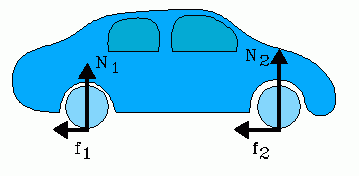Braking automobile

Automobile brakes are often designed differently for front wheels than for the rear wheels. The front wheels are more rugged, and sometimes are disk rather than drum brakes. Why is this?
Solution :- When the automobile brakes, you notice that the front dips down. The front springs compress more than the rear ones, and the front tires do also. This indicates there's more vertical force on the front axle than on the rear.
The reason this happens is that the force of friction of the roadway on the tires produces a clockwise torque about the car's center of mass (see picture below). The vertical normal forces on the tires must adjust in size to produce an equal and opposite counterclockwise torque.
In the light of the previous problem of the sliding cube, the reason is clear. The center of mass of the vehicle is between the front and rear axles, and above them. Therefore the force due to friction between roadway and tires provides a torque that initiates a rotation, causing the downward dip of the front of the vehicle. This compresses the front springs more, causing the normal force to be greater at the front than at the rear. This torque is opposite to the torque due to friction, The forces on the tires due to friction f1 and f2 at the roadway are linked to the normal forces N1 and N2 through the relation f = μN where μ is the coefficient of friction. So, since N2 is greater on the front tires than is N2 on the rear tires, the friction at the roadway is also greater on the front tires. The brake drums or disks in the front also have an increased force due to friction, hence they must be more rugged.
Easy Math Editor
This discussion board is a place to discuss our Daily Challenges and the math and science related to those challenges. Explanations are more than just a solution — they should explain the steps and thinking strategies that you used to obtain the solution. Comments should further the discussion of math and science.
When posting on Brilliant:
*italics*or_italics_**bold**or__bold__paragraph 1
paragraph 2
[example link](https://brilliant.org)> This is a quote# I indented these lines # 4 spaces, and now they show # up as a code block. print "hello world"\(...\)or\[...\]to ensure proper formatting.2 \times 32^{34}a_{i-1}\frac{2}{3}\sqrt{2}\sum_{i=1}^3\sin \theta\boxed{123}Comments
Simple concept behind the Automobile brakes has been mentioned in this article in an impressive manner. One must visit https://topicsmill.com/speech/technical-speech-topics/ for more help in research paper topics. I have also understood the working methodology of vehicle brakes.